calsfoundation@cals.org
Original Tuskegee Airmen
aka: Tuskegee Airmen, Original
Arkansas’s original Tuskegee Airmen were a part of a segregated group composed of African American Army Air Corps cadets, personnel, and support staff known as the Tuskegee Airmen. There were twelve Arkansans documented who performed and maintained various roles at the Tuskegee Institute in Alabama. Those roles included flight instructor, pilot, flight officer, engineer, bombardier, navigator, radio technician, air traffic controller, parachute rigger, weather observer, medical professional, and electronic communications specialist. Other support staff may have included Arkansans. The term “original” is applied to the individuals who received government and civilian instructional training while at Tuskegee between 1941 and 1946. Approximately 992 pilots were trained at Tuskegee, 450 of whom saw action overseas during the war; four of those were Arkansans.
World War II Tuskegee Fighter Pilots from Arkansas
Woodrow W. Crockett (1918–2012) was born in Homan (Miller County) and lived in Little Rock (Pulaski County), where he attended Dunbar High School and Junior College before leaving to join the army in August 1940. In 1942, Crockett transferred to the Tuskegee Institute and became an aviation cadet. He graduated and was commissioned as a second lieutenant on March 25, 1943. Crockett served in the 100th Fighter Squadron and the 332nd Fighter Interceptor Group, flying 149 combat missions in fifteen months. He was stationed at McGuire Air Force Base and McCloud Air Force Base in Washington as a member of the Twenty-fifth Air Division, as well as Edmond Air Force Base in California. He was a graduate of the United States Air Force Command and Staff College in Montgomery, Alabama. Crockett later served in the Korean conflict, completing forty-five missions and receiving numerous awards and accolades. Crockett retired after thirty years of military service in 1970 with over 5,000 hours of flight time and 520 combat hours. In 1992, he was inducted into the Arkansas Aviation Hall of Fame and, in 1995, was made a member of the Arkansas Black Hall of Fame.
William T. Mattison (1914–1951) was born on October 4, 1914. He was schooled at the Pine Street School in Conway (Faulkner County) and attended Arkansas AM&N College (now the University of Arkansas at Pine Bluff), receiving a BS in 1937, and Howard University in Washington DC. He became a rural school teacher in Union County before being drafted into the U.S. Army on April 9, 1941. Mattison graduated from Tuskegee’s flight program on October 9, 1942, as a second lieutenant. Mattison served as operations officer and a member of the famed 100th Squadron in Italy. Mattison also provided leadership to the 302nd Fighter Squadron in March 1943 and was a member of the 332nd Fighter Squadron (Red Tails). He was one of the most decorated Arkansans during any time of conflict, rising to the rank of major and earning the Flying Cross, the American Defense Service Medal, the American Campaign Medal, and two Bronze Service Stars, among numerous other awards for campaigns in Rome, Arno, southern France, the Rhineland, the Balkans, northern France, the northern Apennines, and Po Valley. Mattison died in an airplane crash en route to Ohio on January 28, 1951, and his remains are buried at Arlington National Cemetery. At the time of his death, he was a professor and head of the Department of Air, Science, and Tactics at Howard University.
Herbert Vanallen Clark (1919–2003) of Pine Bluff (Jefferson County) was born on March 16, 1919. Clark was the first Arkansan to have graduated as a cadet to become a fighter pilot. As a member of class 42-F, he was part of the pioneering group to go directly from the Civilian Pilot Training Program (CPTP) into basic training in 1942. Clark was the first Arkansan of color in the Army Air Corps to be assigned to the 553rd replacement training unit at Selfridge Field, a segregated military facility located about twenty-five miles north of Detroit, Michigan. Clark was a member of the Ninety-ninth Fighter Squadron from its inception and was one of the first Black pilots to have shot down an ME-109, a premier German fighter.
Richard C. Caesar (1918–2011) was born in Lake Village (Chicot County) on April 12, 1918. In 1942, Caesar became the second pilot from Arkansas to graduate from Tuskegee’s single-engine class 42-H (the first was Herbert Clark). He was one of the persons responsible for saving fellow original Tuskegee Airman Dr. Roscoe C. Brown Jr. from a potentially disastrous plane crash in 1943. Caesar was an engineering officer and pilot with the 100th Fighter Squadron. He retired from the air force and lived in Foster City, California.
Non-Combat AOTA Members
Granville C. Coggs (1925–2019) was born on July 30, 1925, in Pine Bluff but moved to Little Rock before being drafted. He served in the Army Air Corps from 1943 to 1946 as an aerial gunner, aerial bombardier, multi-engine pilot, and B-25 pilot trainee. He was scheduled for the 477th Bombardment Group but did not see combat, due to the end of the war. Coggs was a weather observer until the fall of 1946, before being discharged and leaving Tuskegee to attend the University of Nebraska at Lincoln, where he graduated in 1949. In 1953, he became a physician upon completing a medical degree from Harvard Medical School. In 1959, he became the first Arkansan and the first African American to serve as staff physician at Kaiser Hospital in San Francisco. In 1972, he became the first head of the Ultrasound Radiology Division at the University of California at San Francisco. A longtime resident of San Antonio, Texas, Coggs died on May 7, 2019.
Jerry T. Hodges Jr. was born in Heth (St. Francis County) on June 29, 1925. He left Arkansas in 1943 to attend Hampton University in Virginia and, after three semesters, enlisted in the Army Air Corps on June 12, 1944, shortly after the D-Day invasion in France. Hodges completed flight training on September 8, 1945. After his training was complete, he served as base statistical control officer and was an administrative assistant to the Director of the Twin Engine (TE) Flight Training Program at Tuskegee Army Air Field (TAAF) until June 1946. He was assigned to the 617th Bomb Squadron of the 477th Composite Group but was released to continue his college education. He graduated in 1950 from the University of Southern California with a BS in accounting. By 2008, Hodges was a semi-retired accountant operating his own financing company in Los Angeles, California.
Arkansas Flight Officers (Non-Combatants)
Arkansas produced two flight officers (F/Os), or navigators, during the height of the Tuskegee era—James Ewing and Denny C. Jefferson. Ewing was from Helena (Phillips County) and graduated from the 44-F-TE class on June 27, 1944. He was assigned to Godman Field in Kentucky as a crew chief gunner with Special Order Ninety-one. Jefferson was from Little Rock and graduated from class B-445 on October 10, 1944. He was assigned to Randolph Field near San Antonio, Texas. Jefferson was the only Arkansan arrested at Freeman Field in Seymour, Indiana, on April 13, 1945, when 101 air force officers were taken into custody after an organized peaceful demonstration against Jim Crow practices at an all-white officers’ club. Jefferson was a member of the “E” Squadron, 118th AAF Base Unit during the time of the protest. In a non-combat routine flight from Godman Field in Kentucky to Gunter Field in Alabama, Jefferson and six other crew members, were killed when their B-25 bomber went down in a swamp four miles east of Gunter Field in mid-June 1945.
Marsille P. Reed was from Tillar (Drew and Desha Counties). He was born in 1917 and enlisted in the armed services on February 16, 1942. Reed graduated on March 11, 1945, as a member of the class 45-A-SE. Little other information is available on him or fellow airman Aurelius Marcus Perkins, another early Arkansan at Tuskegee. According to William Holton, national historian of the Tuskegee Airmen Incorporated, Perkins was listed as being from Little Rock and joining the CPTP at Tuskegee in August 1941.
Alexander S. Anderson (1919–1975) was born on November 12, 1919. He was one of the first African American paratroopers and served in both the Korean and Vietnam conflicts. According to George L. Washington, director of pilot training at Tuskegee, Anderson executed the first parachute jump at Tuskegee and later became a pioneer in the use of parachutes. On March 25, 1940, Anderson received one of the highest scores on the standard written examination required of all CPTP students at Tuskegee and was featured in the March 1941 edition of Popular Aviation.
Milton Pitts Crenchaw (1919–2015) was born in Little Rock on January 13, 1919, and was one of the first African Americans—and the first from Arkansas—to be trained as a civilian licensed pilot. He later trained hundreds of cadet pilots while at Tuskegee at the beginning of his forty-year career with the U.S. Air Force. He later helped start a flight program at Philander Smith College. He was inducted into the Arkansas Black Hall of Fame in 2007.
For additional information:
Cooper, Charles, and Ann Cooper. Tuskegee’s Airmen, Featuring the Aviation Art of Roy LaGrone. Osceola, WI: Motorbrooks International Publishers & Wholesalers, 1996.
Davis, Edmond. “The Original Tuskegee Airmen: Pulaski County African American Pilots of World War II.” Pulaski County Historical Review 56 (Winter 2008): 121–129.
———. Pioneering African-American Aviators: Featuring the Tuskegee Airmen of Arkansas. Little Rock: Aviate Through Knowledge Productions, LLC, 2012.
Dryden, Charles W. A-TRAIN: Memoirs of a Tuskegee Airman. Tuscaloosa: University of Alabama Press, 1997.
Frances, Charles E., and Caso Adolph. The Tuskegee Airmen: The Men Who Changed a Nation. 5th ed. Wellesley, MA: Branden Books Publishing, 2008.
Homan, Lynn M., and Thomas Reilly. Black Knights: The Story of the Tuskegee Airmen.. Gretna, LA: Pelican Publishing Co, 2001.
Travis, Dempsey J. Views from the Back of the Bus during WWII and Beyond. Chicago: Urban Research Press Inc., 1995.
Washington, George L. The History of the Military and the Civilian Pilot Training of the Negroes at Tuskegee, Alabama, 1939–1945. Washington DC: 1972.
Edmond Davis
Pulaski Technical College

 Roscoe Brown
Roscoe Brown 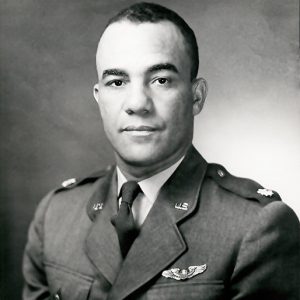 Herbert V. Clark
Herbert V. Clark 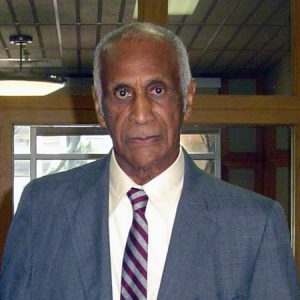 Milton Crenchaw
Milton Crenchaw  Woodrow W. Crockett and Bill Clinton
Woodrow W. Crockett and Bill Clinton 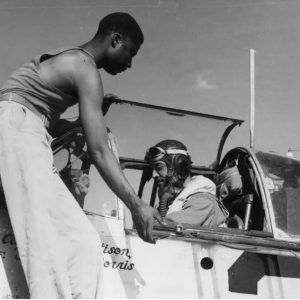 William T. Mattison in Plane
William T. Mattison in Plane 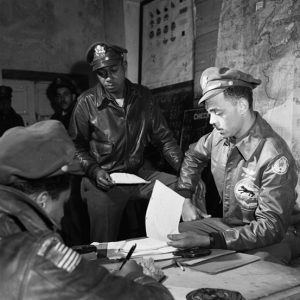 Original Tuskegee Airmen
Original Tuskegee Airmen  Tuskegee Airmen
Tuskegee Airmen 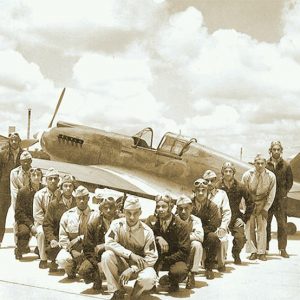 Tuskegee Airmen Class 42-F
Tuskegee Airmen Class 42-F 



Although this narrative pays homage to the influence and the pride that we as black Americans take from the Tuskegee Airmen, my first-hand experiences consist of meeting the Airmen of St. Louis, MO (especially knowing that my former teacher and neighbor, the late Dr. Victor Reef Sr., served as an instructor of the Airmen) and in joining another neighbor (coincidentally, a close cousin of Airman Roy LaGrone, named L. C. LaGrone) in attending their 2006 Pine Bluff, AR, family reunion. We “agreed to be cousins” because L. C.’s family roots were in Amory, MS, and mine are 70 [?] miles away in Nettleton, MS. My Johnson family roots [maternal grandmother Bettie and lost brother, Eddie?, were from Pine Bluff and Little Rock also]. I mention these because LaGrones, Leggroans, and similarly named folk identify with the contributions of Roy LaGrone, specifically. I give thanks to your organization as well as thanks to the books of Cooper and all historians of the Tuskegee Airmen. In my endeavor to expand the written history of the black LaGronesfrom slavery, to sharecroppers, to Mormon travelers, to Utah/Idaho homesteaders, to active military men, to northern city migrants, to educators, to business folk and more, the role of artist Roy LaGrone as a Tuskegee Airman [credited with painting the first nickname insignia on a fighter ace’s plane] will continue to be exemplary of the contributions that the LaGrone family, as well as other black families, have made to the positive history of the U.S.A.
This is a wonderful project that I have to look at in much more detail. There are several good, exciting presentations on these true Americans, and they deserve continued recognition. The current atmosphere of 2012, Jan.-March is a great start with the movie Red Tails, MLK Day, Black History Month, etc.!
We in St. Louis, Missouri, take extreme pride in the group of Tuskegee Airmen who lived and, some still live, and thrive in the history of Tuskegee. We also beam over our young people who still attend and graduate from the Alabama institution. It is more than a “state” school.
The history of Tuskegee Airman Roy LaGrone is a magnet for bringing members to our family reunions–Arkansas, Mississippi, Missouri, and more. It is a theme (contributors to aviation) that helps us connect to the families of white pilot John “Tex” LaGrone, one of the Lindbergh “Early Bird” pilots of 1920s, and more.
In the schools of America (St. Louis County), there is a black-and-white documentary on the Tuskegee Airmen that has original footage interviewing several Airmen, including Roy LaGrone and Dr. Victor Reef.
The LaGrones of Pine Bluff, Arkansas, and I relate from our Mississippi heritage (Tupelo/Amory).
Another American Hero from Arkansas: Shelby Westbrook was born in Marked Tree. When his parents passed away, he moved in with his brother in Toledo, Ohio. In March 1943, shortly after he graduated from high school, Westbrook enrolled in aviation cadet training at Tuskegee Army Air Field. (He’d never been in an airplane, but he knew he didn’t want to be in the infantry.) As a combat pilot, he flew 60 missions over 12 countries in Europe. On his 31st mission, his P-51 Mustang developed engine trouble, forcing Westbrook and his wingman to crash-land in Yugoslavia. After he was rescued by Titos partisans, Westbrook spent a month evading capture and eventually made his way to the coast where he was picked up by the British and returned to his unit. Soon after, Lt. Westbrook was back on duty. For his service in Europe, Westbrook earned the Distinguished Flying Cross, the Air Medal with 5 Clusters, the Presidential Unit Citation, the 15th Air Force Certificate of Valor, and 5 Battle Stars, with a confirmed air-to-air victory over a German Me-109 fighter in October 1944. Promoted to 1st Lt., he served in the 332nd Fighter Group from July 1944 to May 1945. Total service: 4 years active, 6 years reserve. Westbrook returned to the United States in June 1945. His plan was to attend an engineering school, but he was turned down; the director wouldn’t accept black students. Instead, he came to Chicago and earned a Bachelor of Science in electronics from the American Television Institute of Technology. Now retired, he is active in his Tuskegee chapter and has co-authored two books regarding the Tuskegee Airmen, including one named Tuskegee Airmen 1941-1945. In April 2014, Mr. Westbrook was still alive and well in Chicago.